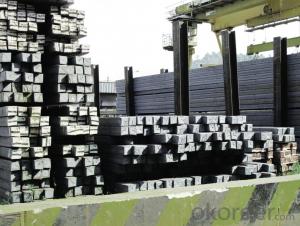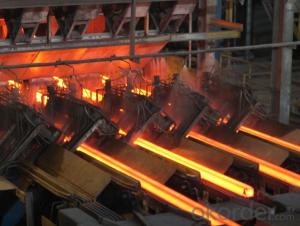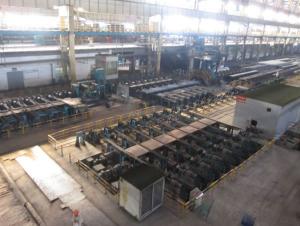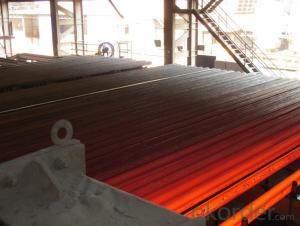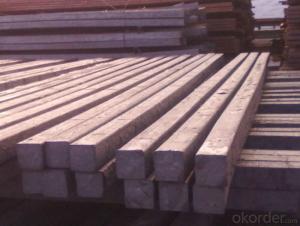Prime square alloy steel billet 100mm Q235
- Loading Port:
- Shanghai
- Payment Terms:
- TT OR LC
- Min Order Qty:
- 100 m.t.
- Supply Capability:
- 10000 m.t./month
OKorder Service Pledge
OKorder Financial Service
You Might Also Like
Structure of Prime square alloy steel billet 100mm Q235

Description of Prime square alloy steel billet 100mm Q235
1) Excellent corrosion resistance: The zinc layer provides a good protection of Pre-painted Galvanizeed Steel Sheet.
2) High heat resistance: The reflective surface of the material aids in efficiently reflecting the sunlight away and in turn reducing the amount of heat transmitted. The thermal reflectivity converts into energy savings.
3) Aesthetics: Pre-Painted Galvanized steel sheet is available in plethora of patterns and multiple sizes as per the requirements that given by our customers.
4) Versatility: can be used in the various areas.

Main Feature of Prime square alloy steel billet 100mm Q235
Uncoated CR steel sheet
With the features of in line with the international highest standards in demension and shape, excellent surface finish and properties, the products are mainly used in home appliance and automobile industries.
Galvanized steel sheet(include HDG and EG)
With the features of good corrosion resistance, the products are mainly used in automobile, home appliance, electronics, building and machinery manufacture industries, etc.
Precoated steel sheet
With the features of enviromental protection and good processablility, long lasting surface durability, rich in colors, the products are maily used in building, home appliance and furniture industries, etc.
Applications of Prime square alloy steel billet 100mm Q235
1) Excellent corrosion resistance: The zinc layer provides a good protection of Pre-painted Galvanizeed Steel Sheet.
2) High heat resistance: The reflective surface of the material aids in efficiently reflecting the sunlight away and in turn reducing the amount of heat transmitted. The thermal reflectivity converts into energy savings.
3) Aesthetics: Pre-Painted Galvanized steel sheet is available in plethora of patterns and multiple sizes as per the requirements that given by our customers.
4) Versatility: can be used in the various areas.

Specifications of Prime square alloy steel billet 100mm Q235
Product | Billet |
Material Grade | SGCC / SGCH / DX51D+AZ, etc |
Thickness | 0.6-3.0mm |
Width | 500-1500mm |
Tolerance | Thickness: +/-0.02mm , Width:+/-2mm |
Zinc-coating | Z30-150g/m2 |
Technique | Raw material: Hot rolled steel coil --> Cold rolled_>hot dipped galvalume |
Surface | Dried, Chromated, Unoiled |
Spangle | Regular spangle , small spangle, zero spangle |
ID | 508MM 610MM |
Coil weight | 1-25MT |
Export package | Cardboard inner sleeves, Waterproof paper, galvanized steel covered and steel strip packed |
FAQ of Prime square alloy steel billet 100mm Q235
We have organized several common questions for our clients,may help you sincerely:
1. How Can I Visit There?
Our company is located in Tianjin City, China, near Beijing. You can fly to Tianjin Airport Directly. All our clients, from home or aboard, are warmly welcome to visit us!
2. How Can I Get Some Sample?
We are honored to offer you sample.
3. Why choose CNBM?
we always fix steel produce in container well to make it safe arrive at destination port
we always provide best and professional forward service for our buyer
we always apply 14days free detention for our buyers container in destination
we provide one set After-sales service for our buyer
we provide China inland steel market price report
we help our buyer become number one in local market .
- Q:What are the typical dimensions and weight of steel billets?
- The typical dimensions of steel billets can vary depending on their intended use and production process. However, common dimensions range from 100mm to 200mm in width and height, with lengths typically ranging from 3 to 12 meters. As for weight, steel billets can weigh anywhere from a few hundred kilograms to several metric tons, depending on their size and density.
- Q:How do steel billets contribute to the manufacturing of machinery and equipment?
- Steel billets are a crucial raw material in the manufacturing of machinery and equipment. They serve as the starting point for various processes such as forging, rolling, and machining, where they are transformed into different components and parts. The high strength and durability of steel billets make them ideal for creating robust and reliable machinery, ensuring the final products can withstand heavy loads, harsh environments, and repetitive use. Additionally, the versatility of steel allows for the production of a wide range of machinery and equipment, from small tools to large industrial machinery, making it a vital component in the manufacturing industry.
- Q:Billet prices skyrocketing weekend, Southern China steel prices rose?
- In December 5th, the billet price in Hebei was 2780 yuan per ton, a new high since two years and three months, a rise of more than 85% over the same period of last year.
- Q:How are steel billets manipulated during the manufacturing process?
- Steel billets are manipulated in various ways during the manufacturing process to transform them into usable steel products. The manipulation techniques include heating, rolling, forging, and cutting. Firstly, the steel billets are heated in a furnace to a specific temperature, known as a rolling temperature. This heating process is crucial as it improves the billet's malleability and reduces its brittleness, making it easier to manipulate. Once heated, the billets are passed through a series of rolling mills. These mills apply pressure to the billets, which elongates and shapes them into the desired form. Rolling can be done using hot or cold methods, depending on the end product requirements. Hot rolling is typically used for large-scale production, while cold rolling is more commonly employed for precision applications. Another method of manipulating steel billets is forging. Forging involves applying compressive forces to the billets using hammers or presses. This process enhances the billet's strength, improves its grain structure, and refines its mechanical properties. Forged steel billets are often used in applications where high strength and resistance to impact and fatigue are required, such as in the automotive and aerospace industries. Cutting is also an essential manipulation technique during the manufacturing process. Steel billets are cut into desired lengths using saws or shears. This step ensures that the billets are converted into manageable sizes suitable for further processing or to meet specific customer requirements. In conclusion, steel billets undergo several manipulation techniques during the manufacturing process. These include heating, rolling, forging, and cutting. Each method contributes to transforming the raw billets into the desired shape and properties, ensuring they are suitable for various applications in industries such as construction, manufacturing, and transportation.
- Q:Can steel billets be heat treated for increased hardness?
- Indeed, it is possible to enhance the hardness of steel billets through heat treatment. The process involves subjecting the steel billets to a particular temperature and subsequently cooling them at a rapid or gradual pace, depending on the desired hardness. This procedure is commonly employed to enhance the mechanical properties of steel, including hardness, strength, and resistance to wear. Several heat treatment methods exist that can be utilized to augment the hardness of steel billets. One prevalent technique is referred to as quenching and tempering. During this process, the steel billets are heated to a high temperature, typically surpassing their critical temperature, and promptly cooled by immersing them in a fluid medium, like oil or water. The rapid cooling induces the steel to harden. However, the steel may become excessively brittle in this state, necessitating tempering by reheating it to a lower temperature. This tempering process mitigates brittleness and heightens the toughness of the steel while preserving its hardness. Another heat treatment method that can be employed to enhance hardness is called case hardening. This technique entails altering the composition of the steel surface to establish a hardened outer layer while maintaining a softer core. Case hardening is typically accomplished by introducing carbon or nitrogen into the surface of the steel billets through processes like carburizing or nitriding. Subsequently, the steel billets are heated to a specific temperature and held for a designated period, permitting the carbon or nitrogen to permeate the steel. This engenders a hardened surface layer, endowing the steel with increased hardness and wear resistance while upholding the core's toughness. In summary, heat treatment can be employed to heighten the hardness of steel billets. The specific heat treatment method chosen will rely on the desired level of hardness, along with other mechanical properties necessary for the steel's intended application.
- Q:How are steel billets used in the manufacturing of electrical equipment?
- Steel billets are often used as the raw material in the manufacturing of electrical equipment. They are typically melted and formed into specific shapes, such as coils or laminations, to create various components of electrical machinery. The high strength and durability of steel make it suitable for withstanding the demands of electrical equipment, ensuring reliable operation and long-term performance.
- Q:What are the common applications of stainless steel billets?
- Due to their exceptional properties and versatility, stainless steel billets find widespread use in various industries. Some common applications of stainless steel billets include: 1. Construction: Extensively used in the construction industry for structural purposes, stainless steel billets manufacture beams, columns, and other load-bearing components due to their high strength and corrosion resistance. 2. Automotive Industry: The automotive industry utilizes stainless steel billets to manufacture components like exhaust systems, engine parts, and suspension components. The high temperature and corrosion resistance of stainless steel make it an ideal choice for these applications. 3. Aerospace Industry: In the aerospace industry, stainless steel billets manufacture critical components such as aircraft frames, landing gear, and engine parts. Stainless steel's high strength-to-weight ratio and resistance to extreme temperatures make it a preferred material in this sector. 4. Oil and Gas Industry: The oil and gas industry widely employs stainless steel billets due to their excellent corrosion resistance. They manufacture pipes, fittings, valves, and other equipment that come in contact with corrosive fluids or gases. 5. Food Processing Industry: The hygienic properties and resistance to corrosion caused by food and cleaning agents make stainless steel billets extensively used in the food processing industry. Equipment like storage tanks, conveyors, and processing machinery are manufactured using stainless steel billets. 6. Medical and Pharmaceutical Industry: The medical and pharmaceutical industry utilizes stainless steel billets for manufacturing surgical instruments, implants, and equipment. Stainless steel's biocompatibility and sterilization capabilities make it suitable for these critical applications. 7. Marine Industry: In the marine industry, stainless steel billets are used to manufacture components such as ship hulls, propellers, and fittings. The corrosion resistance of stainless steel is crucial in the harsh saltwater environment. 8. Power Generation Industry: Power plants employ stainless steel billets for manufacturing boilers, heat exchangers, and turbine components. The high-temperature and corrosion resistance properties of stainless steel make it suitable for these demanding applications. In conclusion, stainless steel billets possess exceptional properties such as strength, corrosion resistance, and temperature resistance, allowing them to have a wide range of applications across industries. From construction and automotive to aerospace and medical sectors, stainless steel billets play a vital role in manufacturing critical components and equipment.
- Q:What is the typical production process for steel billets?
- The typical production process for steel billets involves several steps. It begins with the melting of raw materials such as iron ore, coke, and limestone in a blast furnace. This molten metal is then refined in a basic oxygen furnace or an electric arc furnace to remove impurities and adjust the composition. The refined liquid steel is then cast into molds to form billets, which are rectangular or square-shaped pieces of steel. After solidification, the billets are cooled and then undergo various finishing processes like hot rolling, cold rolling, or heat treatment to achieve the desired properties. Finally, they are inspected, cut into specific lengths, and prepared for shipment to customers or further processing in various industries.
- Q:Can steel billets be used for artistic purposes?
- Yes, steel billets can be used for artistic purposes. Steel is a versatile material that can be shaped, welded, and manipulated to create various artistic sculptures, structures, and decorative pieces. It offers strength, durability, and a modern aesthetic, making it a popular choice among artists and designers. Additionally, steel can be painted, polished, or oxidized to create different visual effects, allowing artists to experiment and showcase their creativity.
- Q:How are steel billets used in the manufacturing of fasteners and fittings?
- Fasteners and fittings rely on steel billets as a vital raw material in their production. These components are essential for securely holding multiple parts together or connecting different sections of a structure or system. To create fasteners and fittings, steel billets undergo a series of steps. Initially, the billets are heated to a high temperature, making them malleable. Known as hot rolling, this heating process allows the billets to be shaped according to the desired form. Subsequently, the billets are passed through rollers that gradually decrease their thickness and increase their length. This transforms them into long, slender rods called wire rods. Next, the wire rods undergo cold drawing or rolling to refine their shape and dimensions further. This process enhances the rods' surface finish and strength. As a result, precise diameter wires are formed, which are then utilized in the production of fasteners such as screws, bolts, and nuts. The wires are cut to specific lengths and threaded to create the grooves and patterns essential for fastening. The threads enable easy screwing into other components, ensuring a secure and reliable connection. The size and shape of the threads are crucial as they determine the compatibility of the fasteners with various applications. In the case of fittings, additional processes are applied to the wire rods, including machining, bending, or welding. Machining involves using cutting tools to shape the wire rods into specific sizes and forms. Bending allows the wire rods to be molded into different angles or curves to fit the desired configuration of the fittings. Welding is employed to join multiple wire rods or other components, enabling the creation of complex fittings. After the manufacturing process, both fasteners and fittings undergo rigorous quality control tests to ensure they meet the required standards for strength, durability, and dimensional accuracy. These tests assess factors such as threading precision, hardness, and resistance to corrosion. In conclusion, steel billets play a crucial role in the production of fasteners and fittings. Through processes like hot rolling, cold drawing or rolling, threading, and various shaping techniques, steel billets are transformed into wires and further processed to create a wide range of fasteners and fittings. These components are vital in industries such as construction, machinery, and automotive.
1. Manufacturer Overview |
|
|---|---|
| Location | |
| Year Established | |
| Annual Output Value | |
| Main Markets | |
| Company Certifications | |
2. Manufacturer Certificates |
|
|---|---|
| a) Certification Name | |
| Range | |
| Reference | |
| Validity Period | |
3. Manufacturer Capability |
|
|---|---|
| a)Trade Capacity | |
| Nearest Port | |
| Export Percentage | |
| No.of Employees in Trade Department | |
| Language Spoken: | |
| b)Factory Information | |
| Factory Size: | |
| No. of Production Lines | |
| Contract Manufacturing | |
| Product Price Range | |
Send your message to us
Prime square alloy steel billet 100mm Q235
- Loading Port:
- Shanghai
- Payment Terms:
- TT OR LC
- Min Order Qty:
- 100 m.t.
- Supply Capability:
- 10000 m.t./month
OKorder Service Pledge
OKorder Financial Service
Similar products
New products
Hot products
Related keywords
